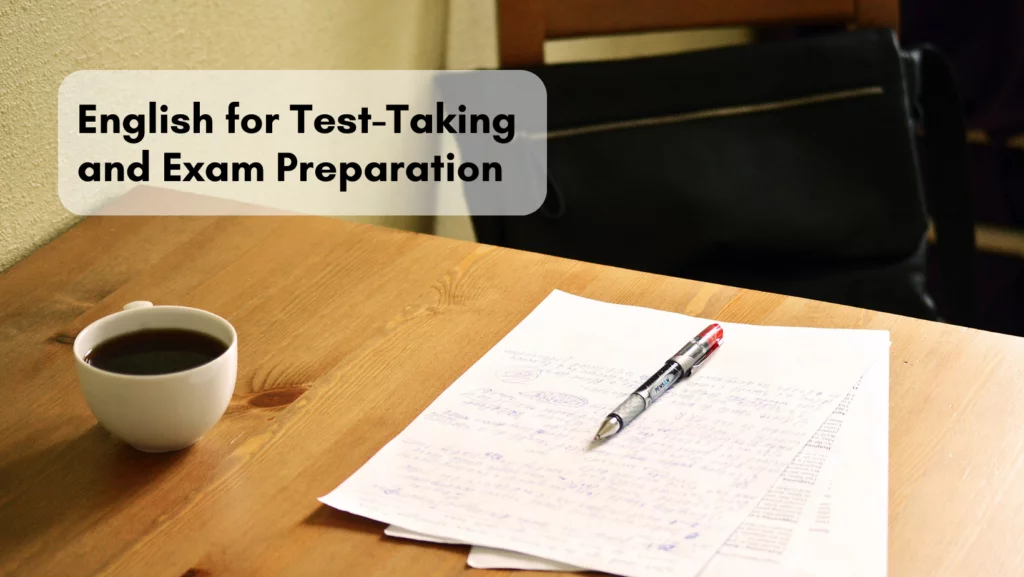Competitive English tests like the IELTS, PTE, and TOEFL can be challenging for native and non-native English speakers, regardless of one’s educational background. According to research, 50% of IELTS exam takers fail to get the desired score during their initial attempt. Our test-taking experts explain the fundamentals of ESL exams in this English for test-taking and exam preparation guide. They highlight the effective English test preparation strategies to help takers get the required score for joining a top-rated campus, graduating high school, or moving to a foreign country.
English for Test-Taking and Exam Preparation: Understand the Different Sections
Knowing the commonly tested questions and how to approach them is the first English for test-taking and preparation strategy. These three sections are the most popular in major ESL exams, such as the TOEFL, IELTS, PTE, GMAT, and Cambridge tests:
Multiple-choices
The reading and listening sections of the ESL have multiple-choice questions. Multiple-choice questions can be confusing due to the close resemblance of the answers or choices provided. Applying the following strategies when answering these questions on the ESL exam can help test takers pass the exam:
- Read the questions first: Reading questions helps students understand what to look for from a text or audio. Questions may contain specific keywords, nouns, phrases, people, places, or arguments that guide examinees towards the correct answer.
- Analyze the text/ audio for answers: Going through the text or listening to audio with the question in mind helps exam takers look for the correct answer(s) from the information provided without going through the multiple choices.
- Match Answers with the best choices: Analyzing the multiple choices last helps exam takers compare their original answers from the passage with the choices provided. If some of the choices have been paraphrased, they can select the answers with the closest meanings to the ones in the passage or audio.
Tips for Preparation Vocabulary Section Exam
Vocabulary questions require test takers to identify the meaning of specific words or phrases in a text or passage. They may also ask for suggestions on synonyms for certain phrases or words. The most effective ways to answer questions on vocabulary on the ESL test is:
- Relating words to the context: The best way to find foreign and complex words’ meanings or synonyms is to relate them to the original text. For example, linking a complex word to the message can help find its meaning if the paragraph discusses a specific idea or process.
Fill the Gaps
These questions require test takers to fill in gaps in a sentence using specific words. The phrases used to fill the gaps must be grammatically correct and relate to the overall meaning or message in a sentence or text. The best ways to answer fill-in-the-gap questions is to:
- Review words before and after a gap: Test takers should analyze the phrases on both sides before inserting any word into the provided gap. By understanding the meaning of the words around the gap, they can choose the correct phrase to enter the gap, depending on the message, tone, or theme of the passage.
- Read the sentences in full: Reading the entire sentence and inserting words without looking at the choices helps examinees get a flow of a text. It also ensures exam takers get an idea of the words that best contribute to the overall development of a sentence or idea – be it an adverb, adjective, or verb, from the choices provided.
Tips for Exam Preparation
Studies show that around 2.5 million and 1.5 million people take the IELTS and TOEFL exams annually, proving how competitive these exams can be. Applying the following English for test-taking and preparation tips can ensure exam takers are ready to sit for their upcoming English test:
- Invest in an English prep course – English tests have specific formats and grading systems. Buying an ESL prep course book from eBay or Amazon or taking an online prep course can help examinees familiarize themselves with the course content.
- Take practice tests – Doing practice quizzes using past papers can help Individuals sitting for the English test understand the exam structure and question format better.
- Expand vocabulary: Exam takers should expand their vocabulary before taking the ESL exam by watching English TV shows, listening to English podcasts, and reading English books, magazines, or newspapers.
- Partner with an English Test Tutor – Working with an English Exam Tutor is an excellent English for test-taking and exam preparation technique as it reduces the time and effort used in studying. ESL teachers recommend the right sections to look for and explain how to answer ESL exam questions.
English for Test-Taking and Exam Preparation: Summary
English tests can be competitive and intimidating, especially for first-time exam takers or those with much riding on the exam. This English for test-taking and exam preparation guide should help individuals with an upcoming ESL test better understand the content tested in the exam and how to best prepare. Our English exam tutors can help prepare exam takers for the ESL exam and take the exam for test takers who feel unprepared.



